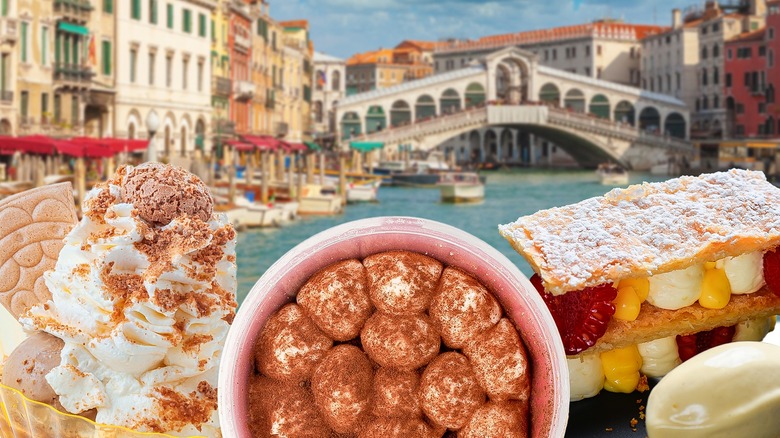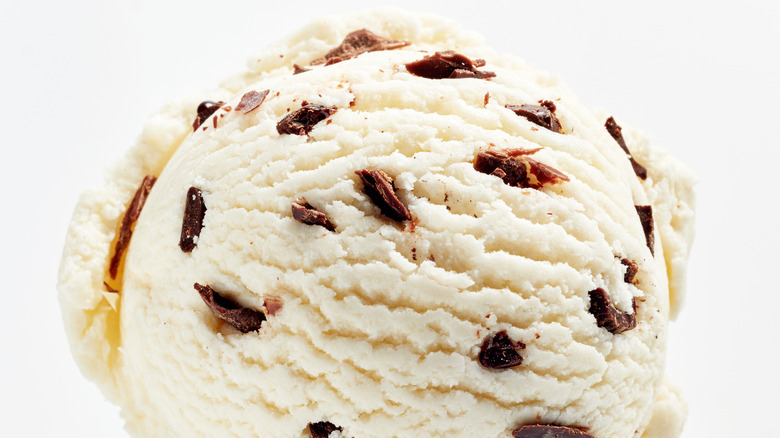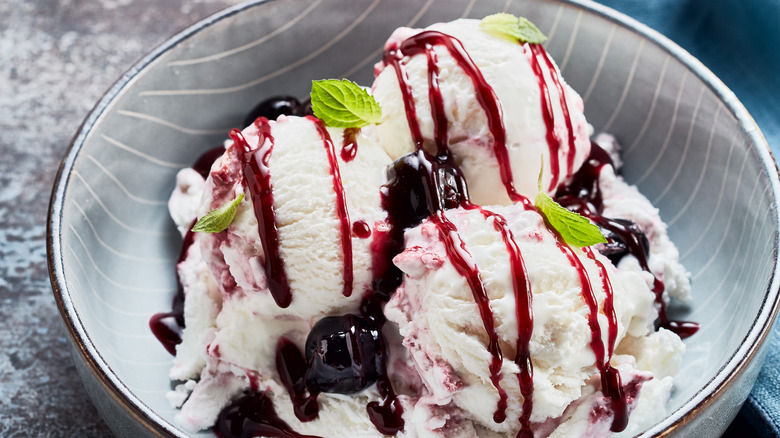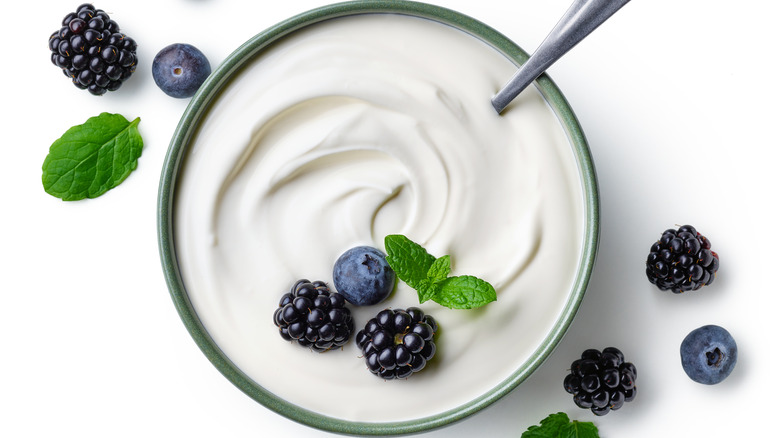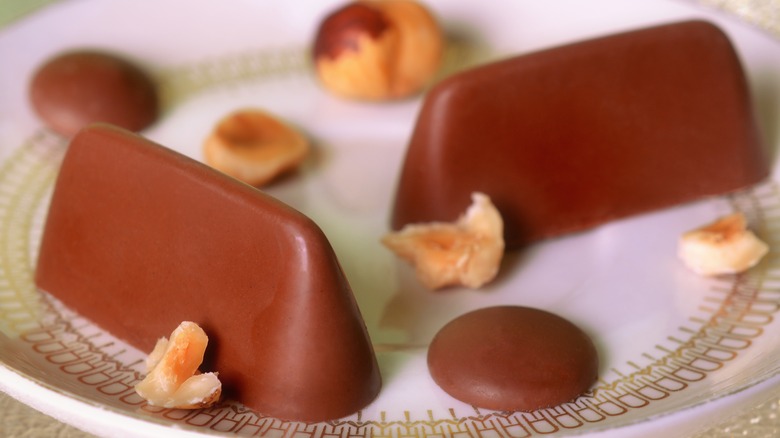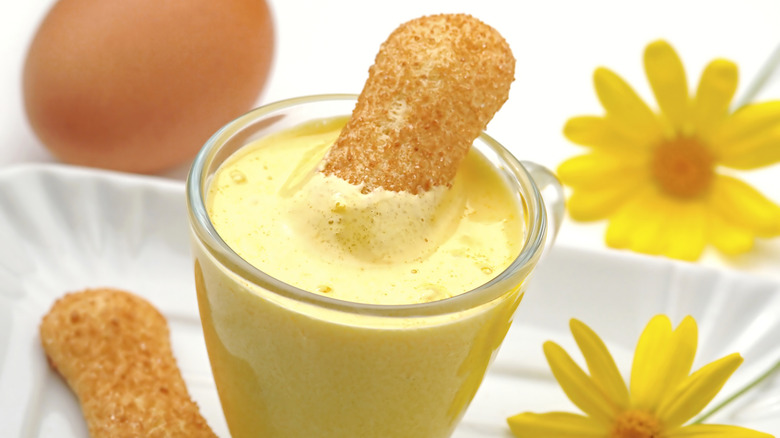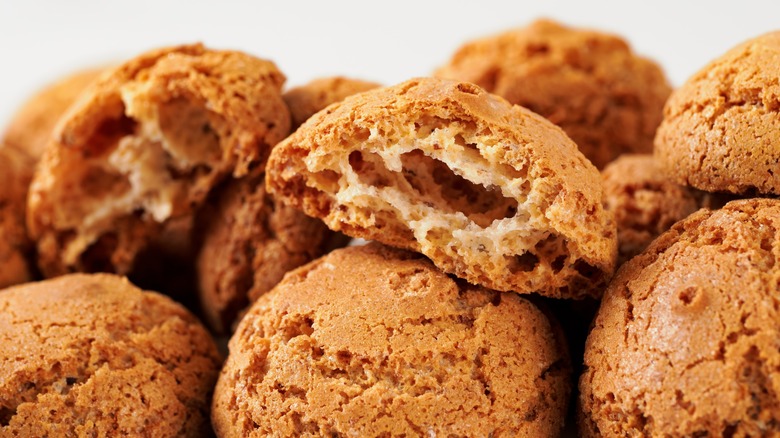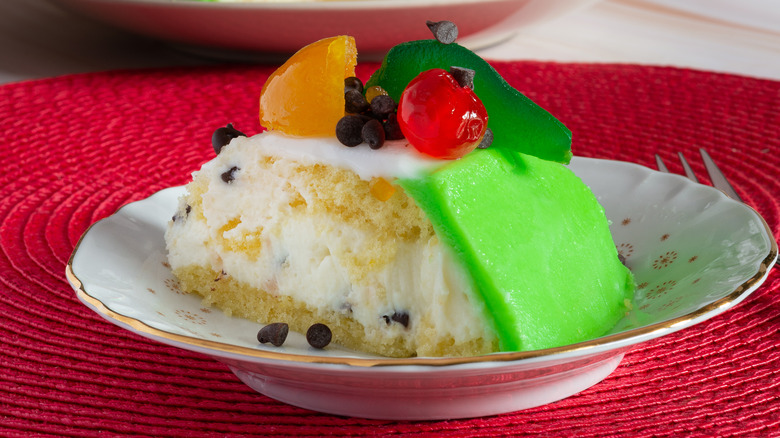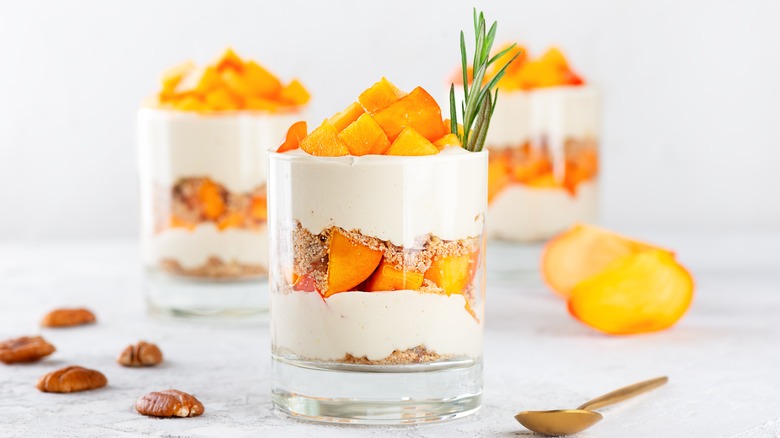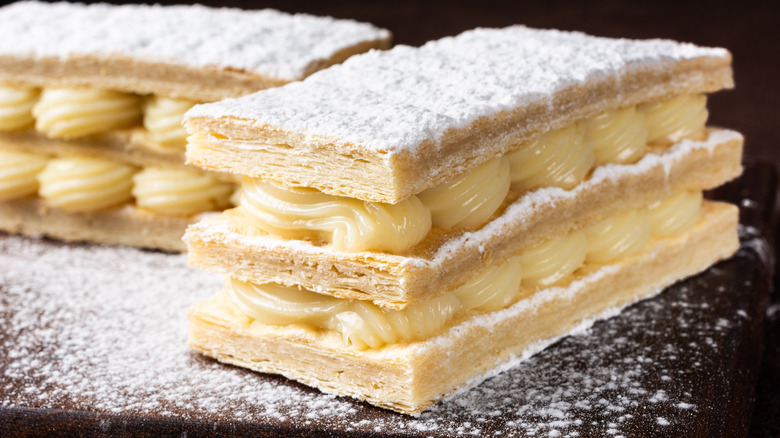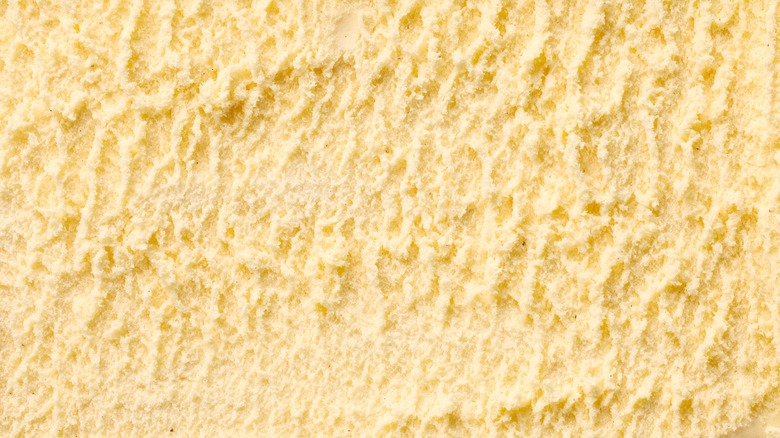13 Popular Italian Ice Cream Flavors You Won't Easily Find In America
When an American orders "gelato" while visiting Italy, they likely expect a specific product that's distinct from regular ice cream. Of course, while gelato is made in a slightly different manner than standard ice cream — using more milk than cream and a slower churning process (which causes less air to get into the mixture) — it's actually just Italian for "frozen." To wit, gelato is the Italian word used for ice cream in the European nation, encompassing both gelato and ice cream.
Roaming the various gelaterias across Italy during my years living in the country, I've noticed these shops tend to stick to a handful of classic options. Though I predictably chose strawberry and lemon as a child, there are numerous additional popular ice cream flavors served throughout Italy — with many reaching into uncharted territory for most Americans. For instance, you won't see stracciatella (a simple vanilla ice cream with chocolate chips) in many U.S. ice cream shops, but you'll likely find it at every gelateria in Italy. Conversely, you won't often see chocolate chip cookie dough ice cream sold in Italy.
With that in mind, there's no reason to stick to the same old flavors if you take a trip to Italy. Here's a list of popular Italian ice cream flavors you won't find easily in the U.S. (and should prioritize trying if you visit the nation).
Fior di latte
Also called fiordilatte, this ice cream flavor represents the product in its simplest form. It's ice cream ... and nothing else. No vanilla or other ingredients interfere with the purity of the milk and cream (and sugar). Literally meaning "flower of milk" — which refers not to actual flowers, but to it using the cream of the crop of milk — you won't find this popular Italian ice cream flavor in many U.S. locations. But you should seek out fior di latte for the creamiest possible gelato when given the chance.
Artisanal gelato shops only use the finest milk to prepare this flavor. When something is made with the best ingredients available, of course, like locally sourced milk, the final result can't help but be exquisite — and that's what happens with fior di latte. This is a great option from any top-notch gelateria, providing you with the best idea of these shops' ice cream-making talents without flavorings getting in the way.
If you want to make fior di latte at home, keep in mind the proper technique involves a step-by-step process that must be followed to the letter. This starts from the moment the sugar is dissolved into milk at low heat, until it's fluffed up in an ice cream machine. You can enjoy the dessert on its own or serve it anything that goes well with vanilla ice cream (like warm apple pie).
Violet
Technically, one can put any type of flavoring into ice cream or gelato. One gelato fair I attended in Padua, Italy offered 500 different flavors, including such whoppers as garlic and lobster, which I did not sample. While most of these never really catch on (for good reason), one unusual-sounding flavor that did make an impact, at least in Italy, is violet. The flavor is typically called "viola" or "violetta" and comes in a predictably purple — or violet — color.
Believed to have been invented in Naples in the late 1800s, you can find violet gelato at ice cream parlors throughout the Mediterranean nation. This popular Italian frozen treat has a flowery flavor and pale purple hue. Plus, if you want to avoid a trip across the ocean to Italy, you can make this at home fairly easily.
You can even stay true to the Italian recipe by picking fresh violets in a nearby field (as my neighbors used to do), then drying them and churning them into your ice cream. Or you could go a more conventional route and pick up some violet extract from the grocery or specialty foods store to impart the necessary flavor profile. If you do come across this option in a gelateria, try pairing it with chocolate ice cream or ask for a thin layer of chocolate sauce to be poured on top.
Stracciatella
This ubiquitous Italian ice cream flavor — consisting solely of vanilla ice cream dotted with very small yet plentiful chocolate chips — might sound familiar to some readers. After all, stracciatella is also the name of a type of cheese as well as a type of soup. Indeed, the name comes from the Italian word "stracciato," which translates to "torn to pieces" or "shredded." While both the soup and cheese resemble foods that have met a torn-to-shreds fate, that's not so with the ice cream.
The origin story for this popular Italian ice cream flavor has more to do with the soup version of stracciatella than the word itself. In 1961, Enrico Panattoni, a restaurant owner in Bergamo, Italy, decided to make an ice cream form of the popular soup just to change things up. Noticing the shards of chocolate appeared to be shredded when he added it to the ice cream, he chose the name as a seeming homage to the soup. The ice cream's appearance comes from a process where the chocolate is warmed and then instantly chilled when it's poured into the ice cream, causing it to flash freeze into tiny specks.
Amarena
You may have heard that one of the ingredients Giada de Laurentiis keeps in her pantry is preserved cherries because she puts them on top of her ice cream. Of course, the celebrity chef didn't come up with this idea herself. In fact, it's actually a quick and easy take on amarena gelato: a popular Italian ice cream flavor you aren't apt to find in many U.S. freezer aisles.
An amarena is a black cherry preserved in syrup (such as those sold by Fabbri). In this gelato, it is stirred into fior di latte ice cream to create a beautiful red swirl dotted with the occasional whole (pitted) cherries. To make this ice cream in true Italian fashion, you'd simply prepare fior di latte then immediately stir in the amarena cherries with their syrup. If that seems like too much of a chore, though, you can take the Giada de Laurentiis route. Pick your favorite vanilla ice cream, then top it with Fabbri cherries without holding back on that extra syrup.
Frutti di bosco
This gelato flavor literally means "fruit of the woods" and refers to a mix of berries such as raspberries, blackberries, blueberries, and strawberries. It recalls those easy, no-churn ice cream recipes you can make by blitzing frozen berries in a food processor with some milk or cream. However, in the real world, the process is more complicated than that and yields a more sophisticated ice cream that's popular across Italy.
The frutti di bosco you find in an Italian ice cream shop is the real deal. Made with milk, cream, sugar, and fresh berries, it's churned in an ice cream maker until smooth. One might almost think this were a sorbet of some kind, but the creaminess of this gelato will instantly disabuse you of that notion. This ice cream can be enjoyed on its own or with other fruity flavors.
Personally, I like to pair it with lemon gelato -– which is actually more of a sorbet and isn't usually made with dairy — as its sour taste offers a counterpoint to the soft and sweet berries. It makes a nice departure from my childhood favorite of strawberry and lemon ice cream, as well, without straying too far from that comfort food.
Yogurt
Unlike American frozen yogurt — which often comes out so thick it's almost chewy (particularly the premade varieties in frozen food aisles) — Italian yogurt gelato is as light and creamy as other gelato flavors. This is due, in part, to the process for making gelato, which allows less air into the product. But it's also because yogurt gelato is often made with fewer ingredients — at least compared to many American store-bought varieties that may contain emulsifiers among other mysterious-sounding ingredients.
Indeed, what you get in an Italian ice cream shop is probably something you could make at home yourself with a bit of whole milk yogurt, cream, and sugar (plus an ice cream maker). While it's fine to add additional flavorings — I've been known to order a frutti di bosco yogurt flavor on occasion — there's also no real need for that. Italians like to keep their foods simple, after all, and in the case of yogurt gelato? The slightly acidic taste of the yogurt does all the work. Still, if that's not enough for you, try this ice cream flavor with a fruity gelato like strawberry.
Gianduja
Gianduja is a type of chocolate invented in the northern region of Piedmont. While hazelnuts abound in Piedmont, there was once a dearth of chocolate due to a political embargo on goods coming from (or through) Britain in the early 1800s. Consequently, gianduja is actually a mixture of hazelnuts and chocolate that was created to extend dwindling cocoa bean supplies. Gianduja continues to be a popular Italian sweet, so much so that it can also be found as an ice cream flavor pretty regularly.
As a frozen treat, gianduja retains much of its delectable flavor profile. The hazelnut element seems to blend with the dairy to create something even creamier and smoother than others. Frankly, when done properly, this might be my favorite ice cream flavor in all of Italy — and I don't even like chocolate very much. If you happen to be in Turin, Italy (in the heart of gianduja country), the best place to sample this flavor may be PapaLele Gelateria. There, you can feast on a gelato that isn't merely flavored with gianduja, but is the very essence of it, too.
Enjoy gianduja ice cream with coconut (which brings out the mutual nuttiness) or my personal favorite combination, violet, which exalts the bittersweet of the chocolate. You can also double down and pair it with a hazelnut ice cream called "bacio," which is another popular Italian ice cream flavor meaning "kiss" in Italian.
Zabaione
Zabaione ice cream, or zabaglione, is a boozy Italian dessert that's thicker than your usual Italian gelato on account of the egg yolk used in the recipe. It also comes with a kick, as it tends to include a dash or two of Marsala, a sweet Italian wine that's sometimes used to make tiramisu. The ice cream is modeled after zabaione cream, a thick, egg-based custard that's so good it's often served on its own (and has also been known to go well with thin wafer cookies).
If you have a hankering for this ice cream and don't happen to be anywhere near Italy at the time, you can make this type of dessert at home with an ice cream maker. You'll have to prepare the zabaione first, of course — on its own — and then add it to your ice cream base of milk, cream, and sugar. The key is to let the zabaione cool completely before incorporating it, as the heat might otherwise interfere with the delicate ice cream making process.
Amaretto
This famous Italian liqueur is often served as a digestif after a meal and is popular in America — but not necessarily in ice cream form. Typically, Americans will see a cocktail prepared with amaretto, or recommend including the liqueur in cupcake frosting. Indeed, the drink pairs well with sweets of all kinds, and even makes a good beverage to enjoy alongside a range of different desserts. One such dessert is ice cream, where Italians pour amaretto liqueur into the mix toward the end of the churning process (and perhaps some crumbled amaretto biscuits, as well).
For good measure, many ice cream shops will also crumble those biscuits on top of the ice cream and cover it completely before putting it on display. This allows for a good amount of crunchy goodness in each scoop (as long as you get one from the top). Just be aware that, in addition to being sweet, amaretto is also slightly bitter, so don't be surprised if the ice cream comes with a bit of a bite.
Cassata
Sicilian cassata cake is an excellent dessert on its own, but Italians like it so much they decided to put it in their ice cream, too. Cassata flavor is one that you'll find in many ice cream shops throughout the country, even in the faraway lands of the north. They might rarely make the cassata itself there, but you can be sure to find it in their ice cream. Of course, the question remains: what exactly is cassata, and how does it translate to ice cream?
Cassata is essentially a sponge cake infused with syrup, filled with ricotta and plenty of candied fruit, and covered in a thin layer of marzipan. The ice cream flavor doesn't just incorporate a slice of cassata, though. It instead recreates the dessert using many of the same ingredients — namely the candied fruit, ricotta, cream, and sugar. In other words, don't expect to find any sponge cake in your ice cream. While Ben & Jerry's and other American ice cream brands have hit the mark by mixing cake or cookie bits into their ice creams, very few (if any) Italian gelatos follow a similar format.
Zuppa inglese
An Italian dessert that strongly resembles an English trifle, zuppa inglese consists of sponge cake or ladyfingers that have been soaked in a spiced liqueur called Alchermes (and sometimes rum) and then layered with pastry cream and chocolate cream. When it comes to the zuppa inglese ice cream, things are a bit different. Rather than scooping out some pre-made zuppa inglese and stirring it into cream and milk, the dessert is mixed into the ice cream in deconstructed form.
It starts with the cream. That's followed by the crushed up, Alchermes-infused ladyfingers, before the chocolate presents in the form of shards instead of cream. If you're making this at home, serve this ice cream topped with a dusting of coffee (as real zuppa inglese is) or with seasonal berries.
Now, be forewarned that this is not your typical light and airy gelato. While it's still not as thick as American ice cream, it still comes with a hefty dose of dairy. Between the cream of the zuppa inglese, the cream and milk in the ice cream, and the condensed milk (not to mention all the alcohol), this treat might leave you wanting a nap afterwards.
Millefoglie
An Italian dessert made with layers of flaky puff pastry and vanilla cream, millefoglie literally means "a thousand sheets" in Italian because of the stacked appearance of the puff pastry layers. Very similar to the French pastry known as "mille-feuille" (which also translates to "a thousand sheets" in French), this dessert lends itself particularly well to ice cream form because of all that cream and pastry.
Naturally, the cream part is taken care of by an ice cream base, while pieces of puff pastry act as the additional ingredients to create a true millefoglie gelato. You may also find chocolate shards in this flavor, though they aren't required. If you want to try making this at home, start by mixing together milk, cream, sugar, and your own crushed bits of cooked puff pastry, then run it through an ice cream machine. Serve the product with berries or top it with chocolate sauce.
Crema
Crema (or cream) ice cream may sound like a redundant flavor. Yet it provides the base for many other kinds of ice cream varieties, including tiramisu and zuppa inglese. Plus, it isn't all that different from a plain vanilla taste-wise, especially since crema recipes call for vanilla seeds. It does differ in texture and heft from vanilla ice cream, though; crema provides more of a pastry cream mouthfeel and is heavier on account of the egg yolks it calls for.
As with fior di latte, sometimes simplicity is the best way to go with crema. It can be enjoyed as is or paired with another flavor. In fact, many Italians often walk into a gelateria and ask for a cone with two scoops of different flavors. Personally, I feel this pull so strongly that I have to remind myself I'm not obliged to order two flavors when getting ice cream in America — which would be a tall order (given U.S. portion sizes).
Since the trick is to pick two types that go well together, consider pairing crema with chocolate, gianduja, or any other cream or milk-based flavor. Strawberry or lemon, which are often more like sorbets than ice cream, may clash with this dessert because of their differing textures, so it may be best to skip those flavors with crema.
